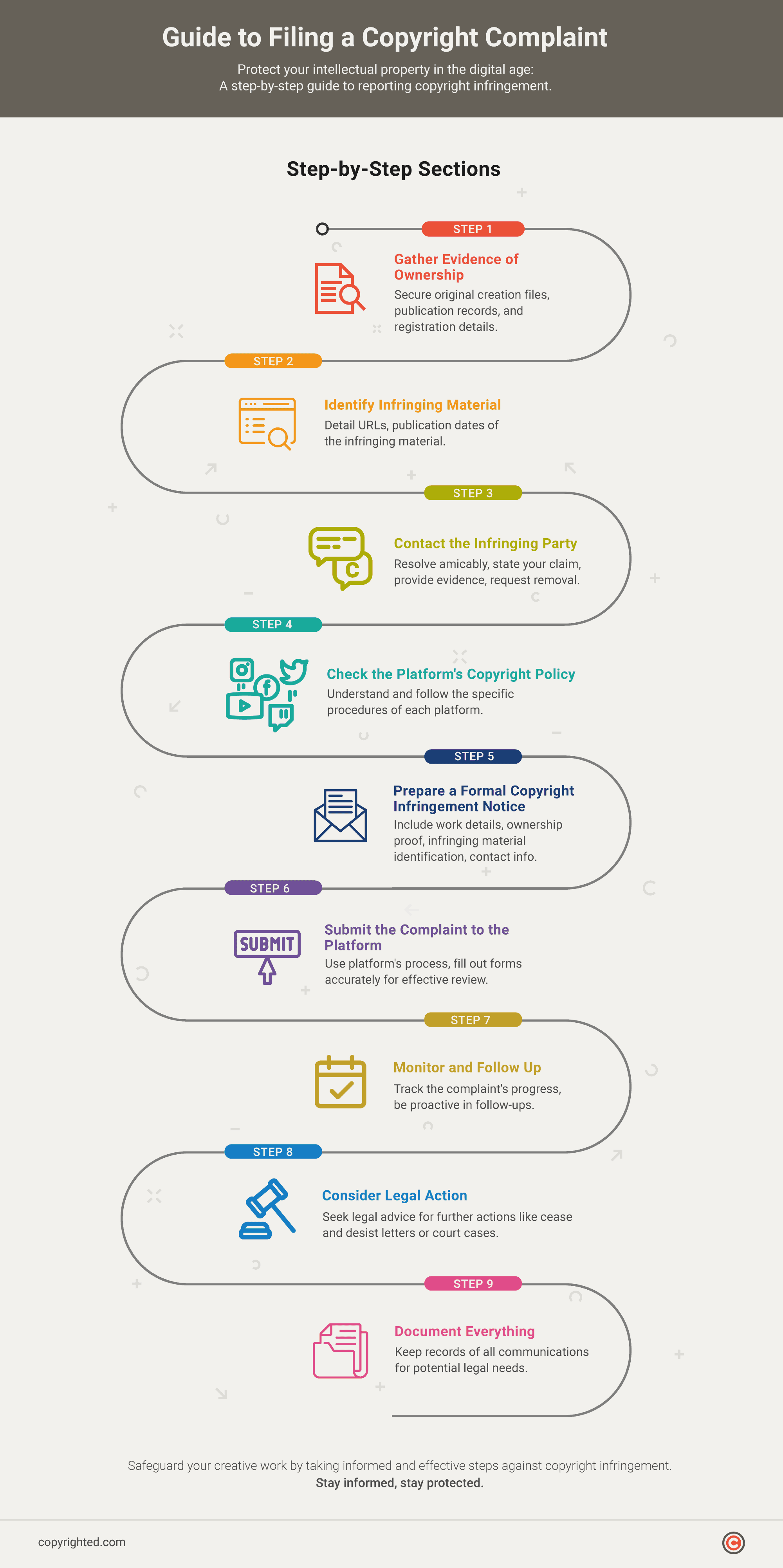A piece of creative work requires a lot of time and effort on your part as the creator. So, it can be disheartening to discover that someone has used your work and falsely claimed it as their own.
While this can be frustrating, it’s essential to stay calm and take action. If you’re dealing with copyright infringement issues for the first time, you’re in the right place.
This article will guide you through understanding copyright infringement complaints, the correct way to file them, and how to take down a website that infringes on your copyrights. Whether you’re a creator, rights holder, or someone accused of infringement, this guide aims to simplify the complexities of copyright complaints for everyone involved.
- Before filing a copyright complaint, you must ensure that you have clear evidence of ownership of the copyrighted material.
- Effective communication and platform policy adherence are important for the complainants and alleged infringers.
- Different platforms often provide specific guidelines on their procedures for filing copyright complaints.
Table of Contents
What Are the Necessary Actions to Take When Filing a Copyright Complaint?
In today’s digital era, protecting intellectual property is crucial as copyright holders face unauthorized use of their works. Filing a copyright complaint requires careful consideration and adherence to specific procedures.
Let’s explore in detail the key actions you must take to report copyright infringement and assert your rights in the face of copyright issues.

1. Gather Evidence of Ownership
Before filing a copyright complaint, you must ensure that you have clear evidence of ownership of the copyrighted material. This may include original creation files, publication records, copyright registration details, or any relevant documentation proving your rights.
2. Identify Infringing Material
Next is to identify the material you believe clearly infringes on your copyright. Provide detailed information such as URLs, publication dates, and other relevant data to help pinpoint infringing content.
3. Contact the Infringing Party
Before legal action, it’s important that you attempt to resolve the issue amicably by contacting the individual or entity responsible for the infringement. State your copyright claim, provide evidence of ownership, and request the removal of infringing material.
4. Check the Platform’s Copyright Policy
Different platforms may have specific procedures and requirements for filing copyright complaints. Familiarize yourself with the copyright policies of the platform hosting the infringing content. Follow their guidelines to ensure your complaint is properly submitted.
For example, Facebook has a complaint form for reporting alleged copyright infringement.
5. Prepare a Formal Copyright Infringement Notice
Now it’s time to draft a formal copyright infringement notice that includes details about the copyrighted work, proof of ownership, identification of the infringing material, and a statement asserting your good faith belief in the infringement. Don’t forget to include your accurate and up-to-date contact information, such as your email address and phone number for seamless communication.
6. Submit the Complaint to the Platform
Follow the platform’s designated process for submitting copyright complaints, including filling out an online form or sending an email to a specified address. Providing accurate information not only speeds up the review process but also strengthens the validity and effectiveness of your complaint.
7. Monitor and Follow Up
After submitting your complaint, monitor its progress closely as platforms may take time to review and respond. Regularly check the status of your complaint and be ready to follow up if needed, maintaining open communication with the platform throughout the process.
8. Consider Legal Action
If the infringing material persists despite your efforts, seek legal advice to explore legal action possibilities. This could include sending a formal cease and desist letter or pursuing legal remedies through the court system, with intellectual property lawyers guiding the process and representing your interests if necessary.
9. Document Everything
One of the most important tasks in handling copyright infringement issues is to make sure you maintain detailed records of all communication, including emails, letters, and responses from the infringing party or the platform. This documentation can be critical in demonstrating your efforts to resolve the issue and may be valuable if legal action becomes necessary.
Recommended Actions For Both Parties Involved in a Copyright Complaint
In the case of copyright issues, effective communication and adherence to platform policies are important for both the complainants and the alleged infringers. Here’s an outline of practical steps for each party involved in a copyright complaint scenario, emphasizing a cooperative approach in line with relevant laws and platform guidelines.
For the Copyright Holder (Complainant):
- Maintain Calm and Professionalism: Approach the situation calmly and professionally, avoiding aggressive or confrontational language.
- Gather and Secure Evidence: Collect and secure all evidence of ownership and infringement before contacting the infringing party or filing a formal complaint.
- Open Communication: Attempt to resolve the issue amicably by initiating communication with the infringing party. Clearly state your copyright claim and provide evidence of ownership.
- Familiarize with Platform Policies: Understand and adhere to the copyright policies of the platform hosting the infringing material. Ensure compliance with their specific procedures for filing complaints.
- Draft a Clear Copyright Notice: Prepare a well-documented and clear copyright infringement notice, including details about the copyrighted work, proof of ownership, identification of infringing material, and a request for removal or cessation.
- Submit Complaint Through Proper Channels: Use the designated channels provided by the platform to submit your copyright complaint. Follow the specified procedures accurately, attaching all necessary documentation.
- Monitor and Follow-Up: Regularly check the status of your complaint and follow up if necessary. Maintain open communication with the platform and be patient as they review and address the issue.
- Consider Legal Advice if Necessary: If the issue persists, consult with legal professionals to explore potential legal actions. They can guide you on the best course of action and represent your interests if legal proceedings are initiated.
For the Alleged Infringer (Respondent):
- Respond Promptly: Respond promptly and professionally if you receive a copyright complaint. Ignoring or delaying a response may escalate the situation.
- Review the Copyright Claim: Carefully review the copyright claim and the evidence provided by the complainant. Assess the claim’s validity and determine if any corrective actions are necessary.
- Remove or Modify Infringing Material: If the complaint is valid, promptly remove or modify the infringing material. This demonstrates a willingness to cooperate and can prevent further legal actions.
- Open Dialogue with Copyright Holder: Engage in open communication with the copyright holder. Acknowledge the complaint, explain your actions or intentions, and discuss potential resolutions.
- Understand Platform Policies: Familiarize yourself with the platform’s copyright policies and comply with their procedures for addressing copyright complaints. This may involve responding to the platform directly or making necessary adjustments to your content.
- Seek Legal Advice if Necessary: If the situation is complex or legal implications arise, consider seeking legal advice. An attorney can help you understand your rights, obligations, and potential courses of action.
- Document Communication: Keep records of all communication with the copyright holder and the platform. This documentation may be valuable if legal actions are taken, helping to establish your cooperation and efforts to resolve the matter.
- Learn from the Experience: Use the situation as an opportunity to learn about copyright laws and best practices. Adjust your actions to avoid future copyright violations and conflicts.
It’s important for both parties to approach the situation with a willingness to resolve the matter amicably and in accordance with applicable laws and platform policies.
How to Take Down a Website for Copyright Infringement?
Addressing copyright infringement on websites demands a systematic and legally sound approach. Let’s discuss the essential steps to take down a website in instances of copyright violation effectively.
1. Understand the Legal Grounds
Familiarizing yourself with the legal grounds for taking down a website is important before initiating any action. This involves researching and comprehending copyright laws and regulations relevant to your jurisdiction.
Ensure your claim is valid by confirming that the alleged infringement falls within the scope of copyright protection. Substantial evidence, such as proof of ownership and a clear demonstration of infringement, is necessary to support your case.
2. Consult Legal Advice
Seeking legal advice from an intellectual property attorney is a wise initial step to assess your case’s strength and receive guidance on the appropriate actions. This consultation ensures a legally sound approach, enhancing the chances of a successful resolution.
3. Identify the Hosting Provider
Effective communication and cooperation with the hosting provider are crucial for removing infringing content, making it essential to determine the provider of the infringing website. Obtain this information through domain registration records or online tools.
4. Check the Hosting Provider’s Policies
Review the hosting provider’s terms of service and copyright infringement policies thoroughly. Ensure your documentation aligns with their guidelines when submitting a complaint, streamlining the takedown process and promoting efficient resolution.
5. Gather Evidence of Infringement
Next, substantial evidence must be collected that clearly demonstrates the copyright infringement on the website. This may include screenshots, URLs, publication dates, and any other relevant information.
6. Prepare and File a DMCA Takedown Notice
Drafting a Digital Millennium Copyright Act (DMCA) takedown notice requires precision.
Include explicit details about your copyrighted work, undeniable proof of ownership, a thorough description of the infringing material, and a statement asserting your good faith belief in the infringement. Craft a clear and concise notice to facilitate the hosting provider’s understanding of the alleged violation.
Then, submit the DMCA takedown notice to the hosting provider through their designated channels. This often involves sending an email or filling out an online form. Ensure that all required information is accurately provided.
7. Follow Up and Monitor
Monitor the status of your takedown request and follow up with the hosting provider if necessary. Some providers may take time to review and act on complaints, so be patient but persistent in seeking resolution.
8. Explore Legal Options
If the hosting provider is unresponsive or the infringing material persists, consult with your attorney to explore legal options. This may involve legal action against the website owner or further communication with the hosting provider.
9. Document the Process
Keep detailed records of all communication with the hosting provider, including copies of the takedown notice, responses received, and any additional correspondence. This documentation can be valuable if legal action becomes necessary.
10. Consider Additional Measures
In some cases, additional measures may be required, such as contacting search engines to remove links to the infringing content or seeking assistance from law enforcement. Consult with legal professionals to determine the most appropriate course of action.
Frequently Asked Questions
What should be included in a formal copyright infringement notice?
A well-drafted copyright infringement notice should include details about the copyrighted work, proof of ownership, identification of the infringing material, and a statement expressing your good faith belief in the infringement.
Why do you need to contact the infringing party before legal action?
Contacting the infringing party before legal action allows for the possibility of resolving the issue amicably, potentially avoiding costly and time-consuming legal proceedings.
When should you consider legal action for copyright infringement?
Legal action may be considered if the infringing material persists despite your efforts. Consult with legal professionals to explore the feasibility and potential outcomes of legal remedies.
How should the alleged infringer respond to a copyright complaint?
The alleged infringer should respond promptly and professionally, reviewing the copyright claim and taking corrective actions if necessary. Ignoring or delaying a response can escalate the situation.
How can you check a platform’s copyright policy before filing a complaint?
Familiarize yourself with a platform’s copyright policies by visiting their official website or reviewing terms of service. Platforms often provide specific guidelines on their procedures for filing copyright complaints.


